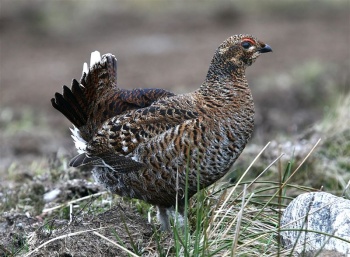(User template. Picture of female added) |
|||
| Line 1: | Line 1: | ||
| − | [[Image:Black_Grouse.jpg|thumb|550px|right|Photo by IanF | + | [[Image:Black_Grouse.jpg|thumb|550px|right|Photo by {{user|IanF|IanF}}<br />Photo taken:Langdon Beck, Teesdale]] |
;[[:Category:Tetrao|Tetrao]] tetrix | ;[[:Category:Tetrao|Tetrao]] tetrix | ||
| Line 8: | Line 8: | ||
==Distribution== | ==Distribution== | ||
| + | [[Image:35827black Grouse female 117 filtered.jpg|thumb|350px|right|Photo by {{user|jtwood|jtwood}}<br />This was one of two female Black Grouse who appeared from behind a rock and entered the Lek while the males were displaying both females started displaying in the centre of the Lek then proceeded to fight it out over a displaying Male, the male then joined in the scrap. ]] | ||
Patchy breeding range in north and west [[Britain]], the Low Countries and [[Germany]], the Alps and the mountains of Central [[Europe]]. More widespread in [[Scandinavia]], found throughout most of [[Norway]], [[Sweden]] and [[Finland]] except the extreme north and from southern and eastern [[Poland]], [[Belarus]] and the Baltic states east across [[Russia]]. | Patchy breeding range in north and west [[Britain]], the Low Countries and [[Germany]], the Alps and the mountains of Central [[Europe]]. More widespread in [[Scandinavia]], found throughout most of [[Norway]], [[Sweden]] and [[Finland]] except the extreme north and from southern and eastern [[Poland]], [[Belarus]] and the Baltic states east across [[Russia]]. | ||
| Line 20: | Line 21: | ||
==Behaviour== | ==Behaviour== | ||
| + | ====Breeding==== | ||
The female builds nest, usually on the ground; 8 -10 eggs are laid from mid May and are incubated for about 24 days by the female who cares for the young. | The female builds nest, usually on the ground; 8 -10 eggs are laid from mid May and are incubated for about 24 days by the female who cares for the young. | ||
| + | ====Diet==== | ||
The diet includes buds, shoots, catkins and berries. | The diet includes buds, shoots, catkins and berries. | ||
Revision as of 17:51, 2 March 2009
- Tetrao tetrix
Identification
Male: 49-55cm. Black plumage, red wattle over the eye, white wingbar, lyre-shaped tail, which appears forked in flight.
Female: 40-45cm. Greyish-brown.
Distribution

This was one of two female Black Grouse who appeared from behind a rock and entered the Lek while the males were displaying both females started displaying in the centre of the Lek then proceeded to fight it out over a displaying Male, the male then joined in the scrap.
Patchy breeding range in north and west Britain, the Low Countries and Germany, the Alps and the mountains of Central Europe. More widespread in Scandinavia, found throughout most of Norway, Sweden and Finland except the extreme north and from southern and eastern Poland, Belarus and the Baltic states east across Russia.
Formerly much more widespread, now rare in many parts of range and no longer breeds in Denmark. The species has been in severe decline in Britain for many years, especially in Wales but there has been a slight recovery there in recent years. Also very rare in northern England and great care should be taken to avoid disturbance. Resident throughout range but there may be occasional movements in the north at times of peak population.
Recorded as a vagrant in Greece, far from normal range although a former breeder in Bulgaria and Turkey.
Taxonomy
The nominate race tetrix is found over most of Europe with britannicus in Britain, male glossed more blue and female darker and more rufous, and viridanus in south-east Russia, males are glossed greener and have more white above, female paler than nominate. Occasionally hybridises with the Capercaillie to produce the "Rackelhahn" and hybrids with Willow Grouse and Pheasant have also been recorded.
Habitat
Forest edge, open forest and clearings, usually conifer or birch. Also swampy heathland and moorland with scattered trees.
Behaviour
Breeding
The female builds nest, usually on the ground; 8 -10 eggs are laid from mid May and are incubated for about 24 days by the female who cares for the young.
Diet
The diet includes buds, shoots, catkins and berries.
Vocalisation
<flashmp3>Tetrao tetrix (song).mp3</flashmp3>
Listen in an external program




